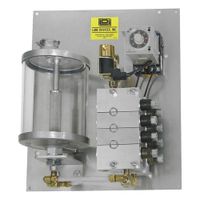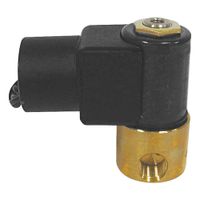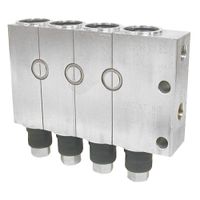Call +(254) 703 030 000 / 751 483 999 / 721 704 777
- Home
- Lubrication
- Machine Mount Lubricators
- Lubrication Systems
.....Read More
Frequently Asked Questions
What is the purpose of a lubrication system?
The purpose of a lubrication system is to reduce friction and wear between moving parts in machinery and engines, ensuring efficient operation and longevity. By providing a continuous supply of lubricant, typically oil or grease, the system creates a thin film between surfaces, minimizing direct contact and thus reducing friction. This not only enhances performance but also prevents overheating by dissipating heat generated from friction.
Additionally, lubrication systems help in protecting components from corrosion by forming a protective barrier against moisture and contaminants. They also assist in cleaning by carrying away debris and particles that could cause damage or blockages. In engines, the lubrication system plays a crucial role in sealing, as it helps maintain pressure by sealing gaps between piston rings and cylinder walls.
Overall, lubrication systems are essential for maintaining the reliability and efficiency of mechanical systems, reducing maintenance costs, and extending the lifespan of equipment.
How does a lubrication system work?
A lubrication system works by reducing friction and wear between moving parts in machinery or engines, ensuring efficient operation and longevity. It typically involves the following components and processes:
1. **Oil Reservoir**: Stores the lubricant, usually oil, which is the medium used to reduce friction.
2. **Pump**: Circulates the oil from the reservoir to various parts of the machine. The pump ensures a continuous flow of lubricant under pressure.
3. **Filter**: Removes contaminants and particles from the oil to prevent damage to the machinery. Clean oil is crucial for effective lubrication.
4. **Oil Lines and Passages**: Channels through which the oil travels to reach different components. These are designed to ensure that oil reaches all necessary parts.
5. **Lubrication Points**: Specific areas where lubrication is needed, such as bearings, gears, and pistons. The oil forms a thin film between surfaces, minimizing direct contact and reducing friction.
6. **Pressure Relief Valve**: Maintains the correct pressure within the system, preventing damage from excessive pressure.
7. **Oil Cooler**: In some systems, an oil cooler is used to dissipate heat generated by friction and maintain optimal oil temperature.
8. **Return Lines**: After lubricating the components, the oil returns to the reservoir via return lines, completing the cycle.
The system can be either manual, requiring periodic application of lubricant, or automatic, where the system continuously supplies lubricant. Automatic systems can be further divided into centralized systems, where a single pump supplies multiple points, or decentralized systems, where each point has its own supply mechanism.
Overall, a lubrication system ensures smooth operation, reduces maintenance costs, and extends the life of machinery by minimizing wear and preventing overheating.
What are the types of lubrication systems?
There are several types of lubrication systems used to reduce friction and wear between moving parts in machinery. These include:
1. **Hydrodynamic Lubrication System**: This system relies on a full fluid film to separate surfaces in relative motion. It is commonly used in journal bearings and involves a thick layer of lubricant that supports the load and prevents direct contact between surfaces.
2. **Boundary Lubrication System**: In this system, the lubricant film is thin, and the surfaces may come into contact. Additives in the lubricant form a protective layer on the surfaces to minimize wear. This is typical in conditions where full fluid films cannot be maintained.
3. **Mixed Lubrication System**: This system is a combination of hydrodynamic and boundary lubrication, where both fluid film and surface contact occur. It is often seen during the transition from rest to motion or vice versa.
4. **Elastohydrodynamic Lubrication (EHL) System**: EHL occurs in highly loaded contacts, such as in gears and rolling element bearings, where the lubricant film is thin, and the surfaces deform elastically. The pressure increases the lubricant's viscosity, forming a protective film.
5. **Solid Lubrication System**: This system uses solid materials like graphite or molybdenum disulfide to reduce friction. It is suitable for extreme conditions, such as high temperatures or vacuum environments, where liquid lubricants are ineffective.
6. **Mist Lubrication System**: This system disperses a fine mist of oil into the air, which then lubricates the surfaces. It is used in high-speed applications like turbines and compressors.
7. **Centralized Lubrication System**: This system automatically delivers lubricant to multiple points from a central reservoir, ensuring consistent lubrication and reducing maintenance needs. It is used in large machinery and industrial applications.
8. **Splash Lubrication System**: In this system, moving parts splash lubricant onto surfaces. It is simple and used in small engines and gearboxes.
Each system is chosen based on the specific requirements of the application, such as load, speed, temperature, and environmental conditions.
How do you maintain a lubrication system?
To maintain a lubrication system effectively, follow these steps:
1. **Regular Inspection**: Conduct routine checks to identify leaks, blockages, or wear in the system. Inspect hoses, fittings, and seals for any signs of damage.
2. **Oil Analysis**: Periodically analyze the lubricant to assess its condition. Check for contamination, viscosity changes, and the presence of wear particles. This helps in determining the right time for oil changes.
3. **Filter Maintenance**: Replace or clean filters regularly to ensure they are free from debris and contaminants. Clogged filters can restrict oil flow and reduce system efficiency.
4. **Proper Lubricant Selection**: Use the correct type and grade of lubricant as specified by the equipment manufacturer. Ensure compatibility with system components to prevent damage.
5. **Scheduled Lubrication**: Adhere to a lubrication schedule to ensure all moving parts receive adequate lubrication. Use automatic lubrication systems where possible to maintain consistent application.
6. **Temperature Monitoring**: Keep an eye on operating temperatures. Excessive heat can degrade lubricants and lead to system failure. Ensure cooling systems are functioning properly.
7. **Reservoir Management**: Maintain proper oil levels in reservoirs. Overfilling or underfilling can lead to operational issues. Use level indicators to monitor and adjust as needed.
8. **System Cleaning**: Periodically flush the system to remove sludge, varnish, and other deposits that can accumulate over time. Use appropriate cleaning agents and follow manufacturer guidelines.
9. **Training and Documentation**: Ensure personnel are trained in lubrication practices and system operation. Maintain detailed records of maintenance activities, oil changes, and inspections for future reference.
10. **Troubleshooting**: Develop a protocol for identifying and addressing issues promptly. This includes understanding common symptoms of lubrication problems and their potential causes.
By following these practices, you can enhance the reliability and longevity of your lubrication system.
What are the benefits of using a lubrication system?
A lubrication system offers several benefits that enhance the performance and longevity of machinery and equipment. Firstly, it reduces friction between moving parts, which minimizes wear and tear, leading to extended equipment life. This reduction in friction also results in improved efficiency, as less energy is wasted overcoming resistance, thereby lowering operational costs.
Secondly, lubrication systems help in dissipating heat generated by moving parts. By absorbing and transferring heat away from critical components, they prevent overheating, which can cause equipment failure or damage. This thermal management is crucial in maintaining optimal operating conditions.
Thirdly, lubrication systems provide a protective barrier against corrosion and contamination. By forming a film over surfaces, they shield components from moisture, dust, and other contaminants that can lead to rust and degradation. This protection is vital in harsh environments where equipment is exposed to adverse conditions.
Additionally, lubrication systems contribute to noise reduction. By ensuring smooth operation of parts, they decrease the noise generated by mechanical movements, leading to a quieter and more comfortable working environment.
Moreover, automated lubrication systems offer the advantage of consistent and precise lubrication delivery. This ensures that the right amount of lubricant is applied at the right time, reducing the risk of over-lubrication or under-lubrication, both of which can be detrimental to equipment performance.
Finally, using a lubrication system can lead to significant cost savings. By reducing maintenance needs, minimizing downtime, and extending the lifespan of machinery, businesses can achieve lower total ownership costs. This makes lubrication systems a critical component in the efficient and reliable operation of industrial and mechanical systems.
How do you choose the right lubrication system for your machinery?
Choosing the right lubrication system for machinery involves several key considerations:
1. **Machinery Type and Requirements**: Understand the specific needs of the machinery, including the type of motion (e.g., linear, rotary), speed, load, and operating environment. Different machines may require different lubrication methods, such as oil, grease, or dry lubricants.
2. **Operating Conditions**: Consider the operating temperature, pressure, and environmental conditions. High temperatures may require synthetic oils, while dusty or wet environments might necessitate sealed systems to prevent contamination.
3. **Lubricant Compatibility**: Ensure compatibility between the lubricant and machine materials to prevent chemical reactions that could cause damage. Check for any manufacturer recommendations or requirements.
4. **Lubrication Method**: Decide between manual, automatic, or centralized lubrication systems. Manual systems are suitable for small, less complex machinery, while automatic or centralized systems are better for large, complex, or critical equipment requiring consistent lubrication.
5. **Maintenance and Monitoring**: Evaluate the ease of maintenance and the ability to monitor lubricant levels and conditions. Systems with built-in monitoring can help in predictive maintenance and reduce downtime.
6. **Cost and Efficiency**: Balance the initial cost of the lubrication system with its efficiency and long-term benefits. An efficient system can reduce wear and tear, extend machinery life, and lower maintenance costs.
7. **Regulatory and Safety Standards**: Ensure the lubrication system complies with industry standards and safety regulations to avoid legal issues and ensure safe operation.
8. **Supplier Support and Service**: Choose a reputable supplier who offers good technical support and after-sales service to assist with installation, troubleshooting, and maintenance.
By considering these factors, you can select a lubrication system that enhances performance, reliability, and longevity of your machinery.
What are common problems with lubrication systems and how can they be fixed?
Common problems with lubrication systems include:
1. **Contamination**: Dirt, water, and other contaminants can enter the system, leading to wear and corrosion. Fix by using high-quality seals, regular oil analysis, and filtration systems to remove contaminants.
2. **Improper Lubricant Selection**: Using the wrong type or grade of lubricant can cause inadequate lubrication. Fix by consulting manufacturer specifications and using the correct lubricant for the application.
3. **Over-lubrication**: Excess lubricant can cause overheating and energy loss. Fix by following recommended lubrication intervals and quantities, and using automatic lubrication systems for precise delivery.
4. **Under-lubrication**: Insufficient lubricant leads to increased friction and wear. Fix by ensuring regular maintenance schedules and using monitoring systems to alert when lubrication is needed.
5. **Oil Leaks**: Leaks can result from worn seals or gaskets. Fix by regularly inspecting and replacing damaged seals and ensuring proper installation.
6. **System Blockages**: Blockages in lines or filters can restrict lubricant flow. Fix by regularly cleaning and replacing filters and inspecting lines for obstructions.
7. **Pump Failures**: Pump malfunctions can halt lubricant flow. Fix by performing regular maintenance checks, ensuring proper installation, and replacing faulty pumps promptly.
8. **Temperature Fluctuations**: Extreme temperatures can affect lubricant viscosity. Fix by using lubricants designed for specific temperature ranges and installing heaters or coolers as needed.
9. **Air Entrainment**: Air bubbles in the lubricant can reduce effectiveness. Fix by ensuring proper system design to minimize air entry and using deaerators if necessary.
10. **Inadequate System Design**: Poorly designed systems can lead to uneven lubrication. Fix by consulting with lubrication specialists to optimize system design and layout.


